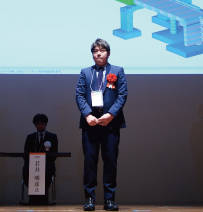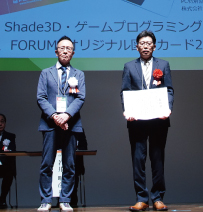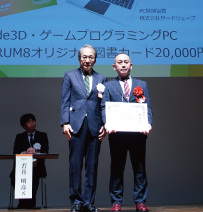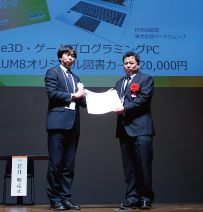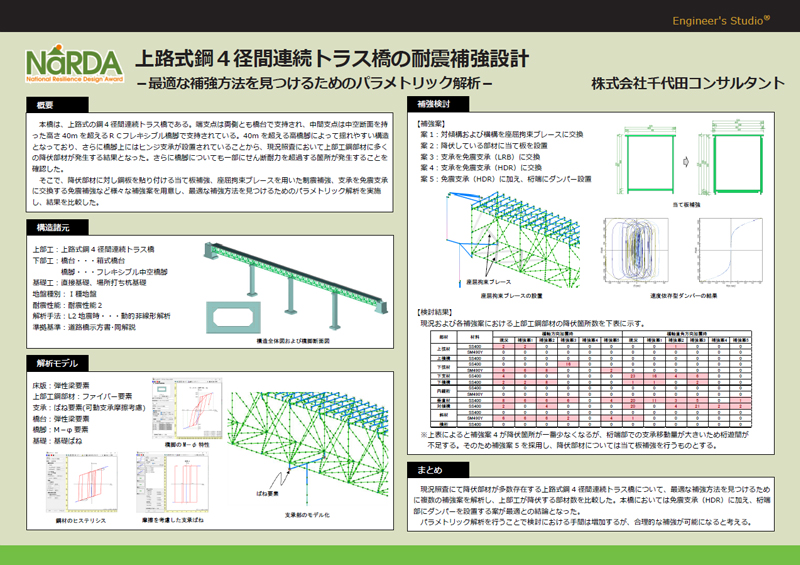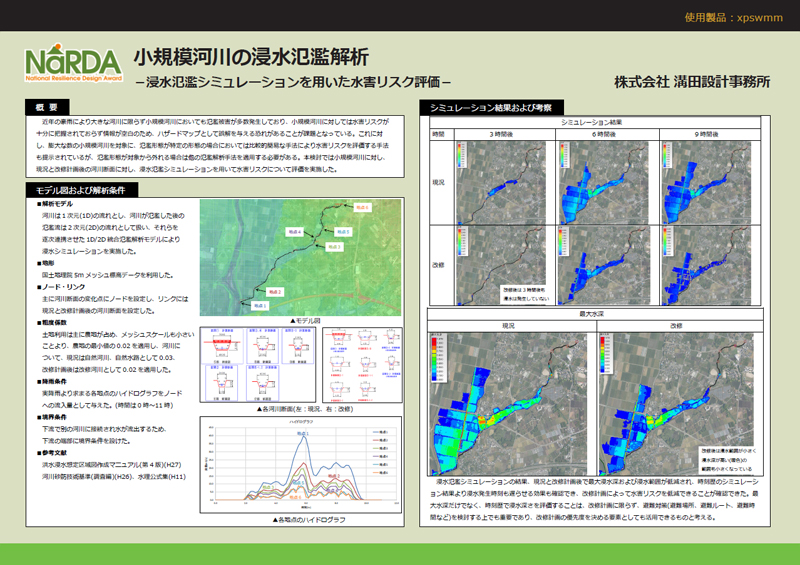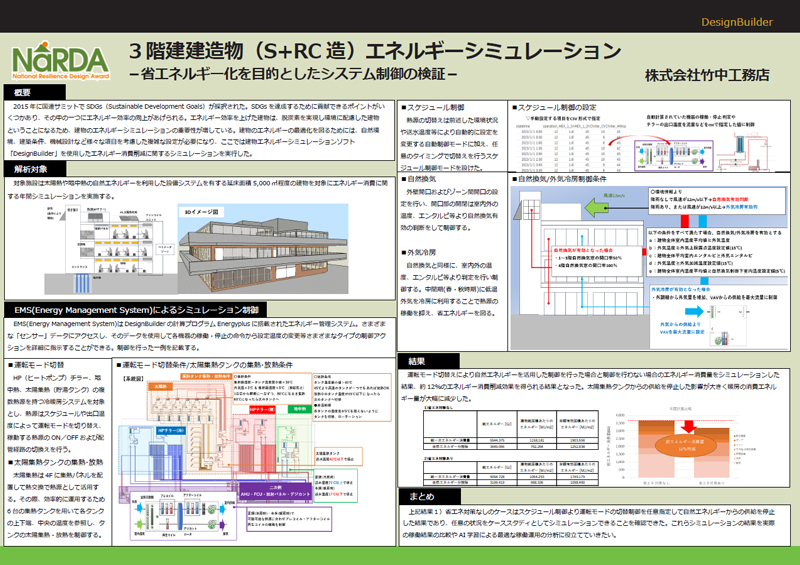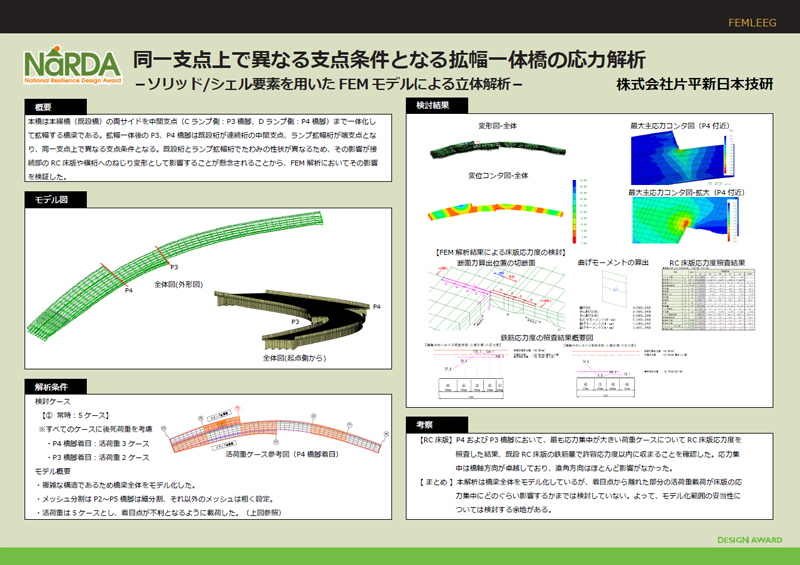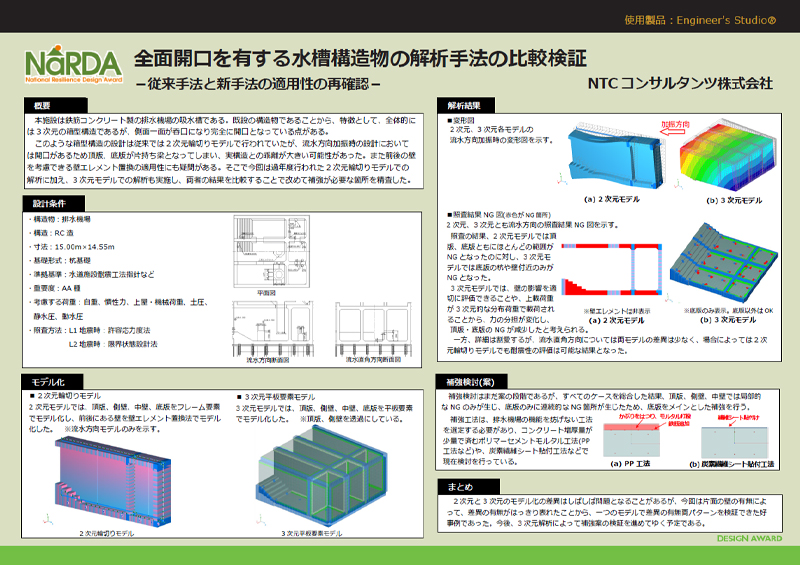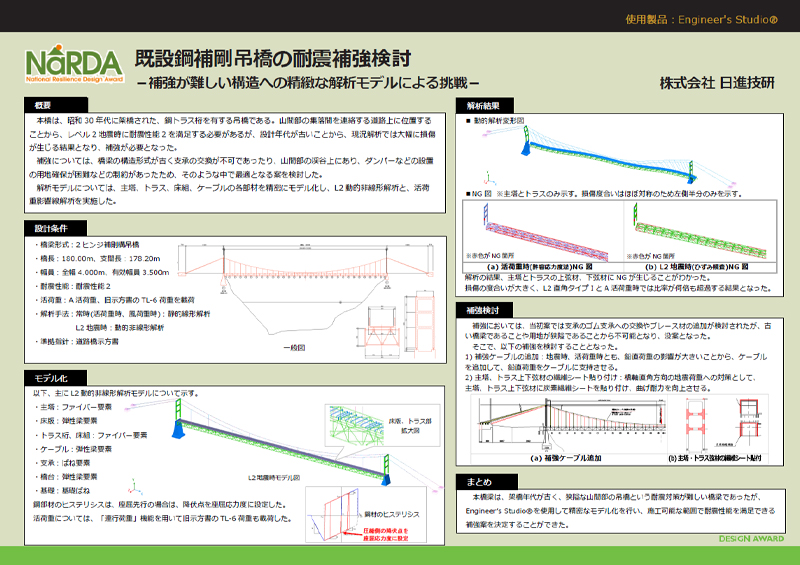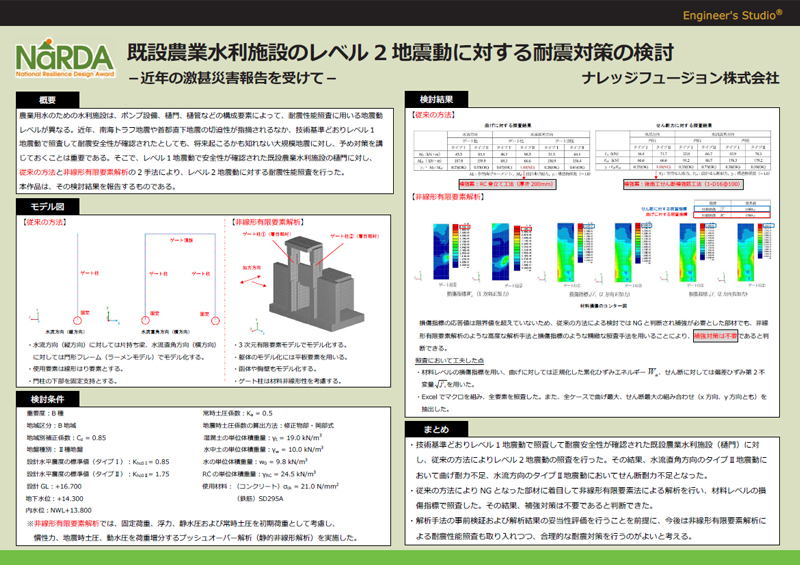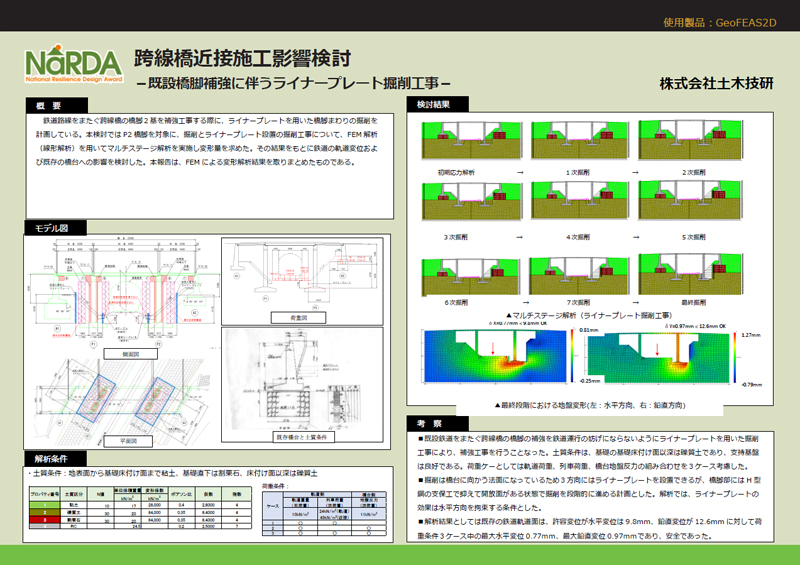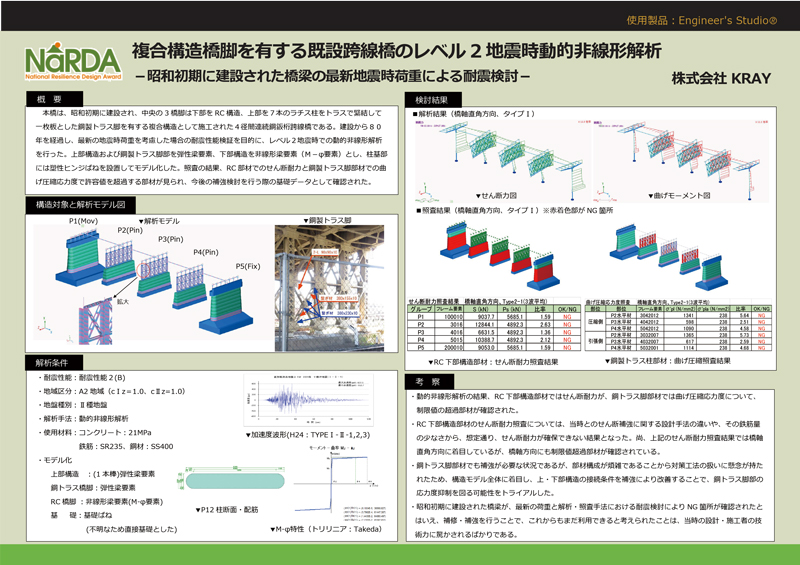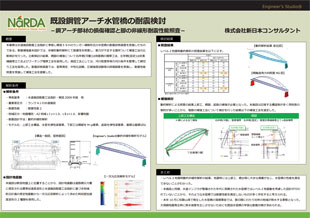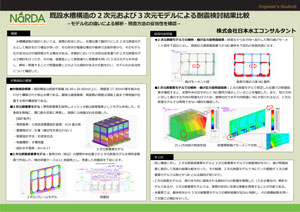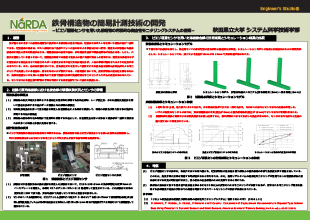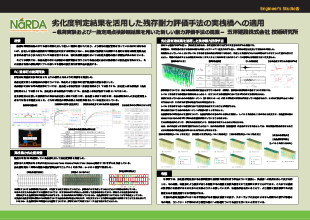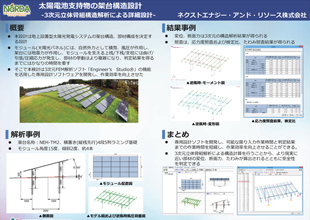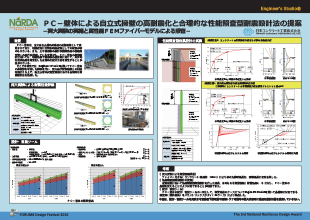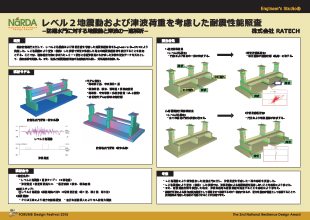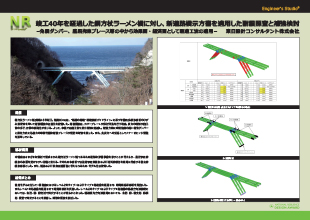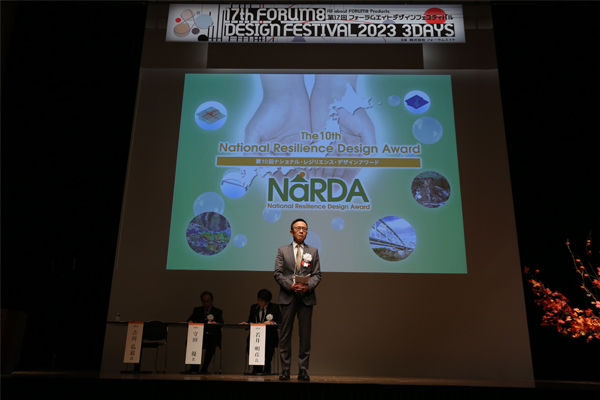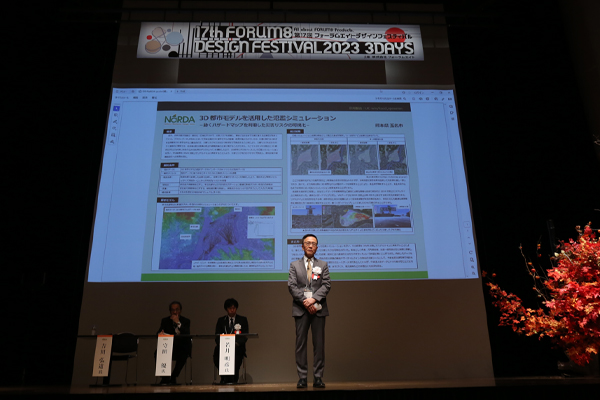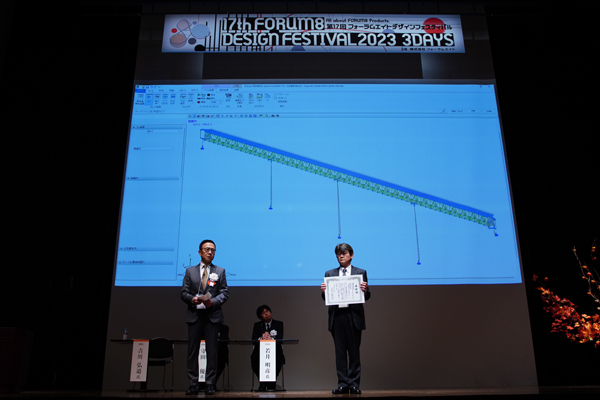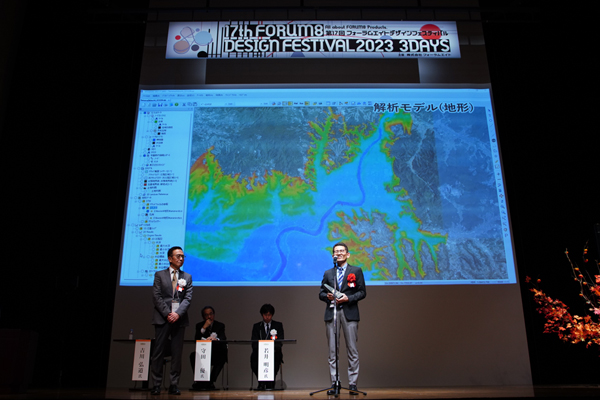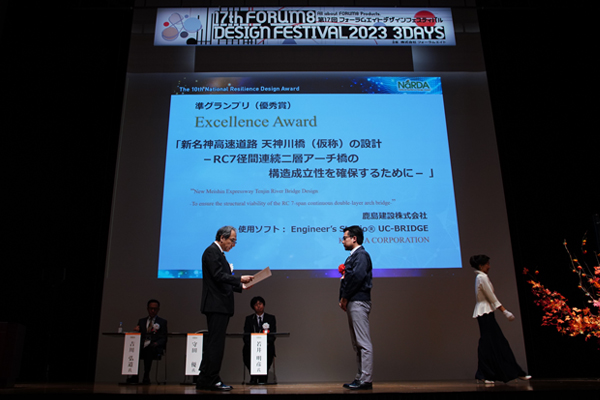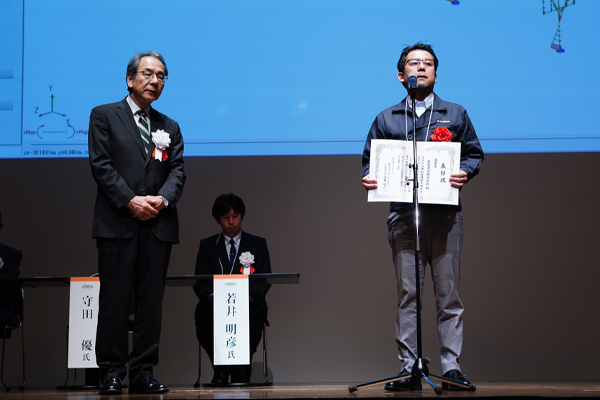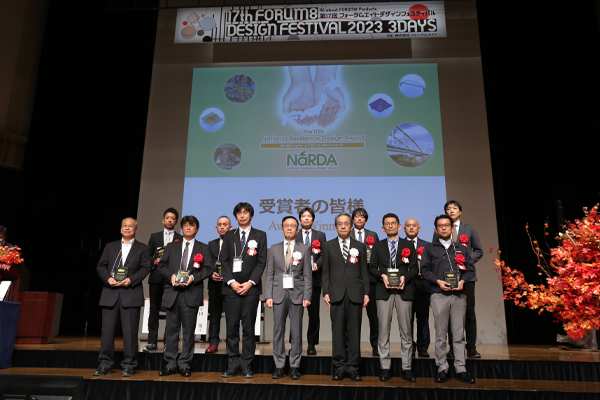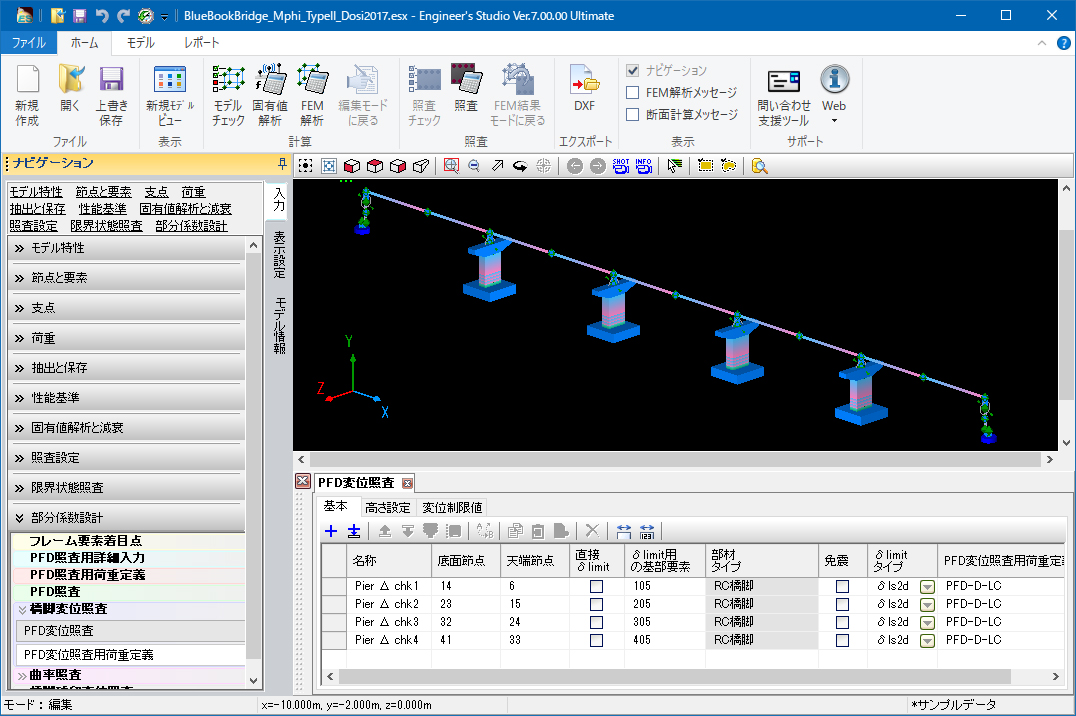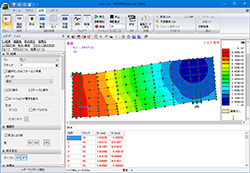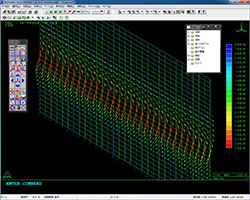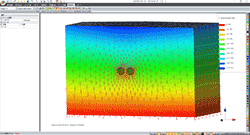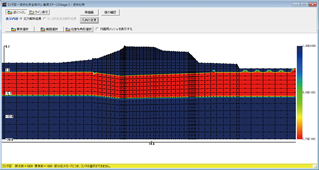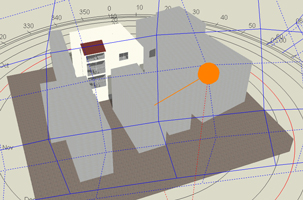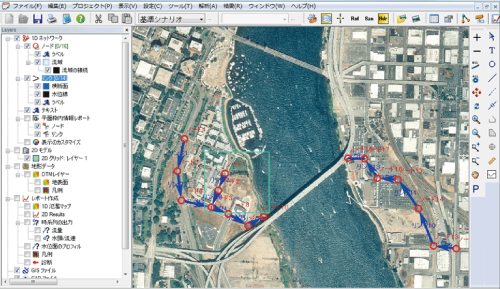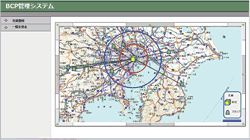
Results
After careful consideration by juries, Grand Prix, Prize, and 3 Honorable Judge Award have been selected. On November 15th 2024, the Awards Ceremony was held at Shinagawa Intercity Hall.
▲Awards Ceremony(November 15th 2024, at Shinagawa Intercity Hall)
-
Grand Prix (Highest Award)
Aratani Civil Engineering Consultants CO.,LTD.
Seismic Performance Evaluation of 3 Simple Steel (Iron) Riveted Truss Bridges
- Seismic Performance Evaluation of Existing Bridges Considering Bridge Structure and Soil Characteristics--
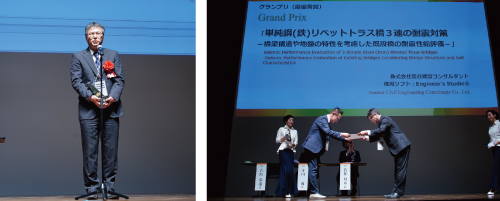
Program Used:Engineer's Studio®
The target structure consists of three simple steel (iron) rivet truss bridge spans with a 45° skew angle, classified as a complex bridge in terms of seismic behavior. Given the need for rapid post-earthquake recovery following a Level 2 earthquake, it was essential to keep the bridge components within the elastic range. Therefore, a seismic response analysis was conducted to assess the existing seismic performance and establish necessary seismic measures.Since this bridge is classified as a special type of bridge with few seismic retrofitting examples, consultations were held with experts in steel bridge design and structural analysis to verify the analysis methods, condition settings, and validity of the results. This ensured a comprehensive approach to setting appropriate seismic countermeasures.
-
2nd Prize (Excellence Award)
NiX JAPAN Co., Ltd.
Evaluation of Existing Seismic Performance of a Steel Single-String Lozenge Bridge and Reinforcement Examination
-Creation of Analysis Model for Rational Reinforcement-Program Used:Engineer's Studio®"This bridge has an 85-meter span with an upward lane constructed with a single steel arch girder and a downward lane constructed with a two-span continuous pre-tensioned I-girder plus a single steel arch girder. The single steel arch girder section is an integrated structure for both lanes, while the PC girder section has a separated structure for each lane.To properly assess the seismic performance of the existing bridge and understand the scope of reinforcement required, dynamic analysis was conducted. This involved creating a fiber model to consider the effects of axial force variations on steel members, and developing a nonlinear model for piers connected to the abutment and beams as framed piers. Additionally, the modeling took into account the resistance of the soil behind the abutments, focusing on the surrounding characteristics. As a result, it was found that the shear capacity of the beam members was insufficient, providing fundamental data for the detailed design of future reinforcements.
-
Honorable Judge Award (Prof. Hiromichi Yoshikawa)
Application of Fiber Model AwardTABUCHI ARCHITECT & ASSOCIATES Co,Ltd.
Proposal of Seismic Performance Verification Method for Existing RC Hollow Piers in Plasticized Region
-Challenges and Solutions for the Application of Fiber Models-Program Used:Engineer's Studio®Experimental results have shown that the failure modes of hollow RC pier sections in existing structures differ from those of solid sections, leading to the limitation of M-φ properties application to "solid sections" as of the H24 specifications. Consequently, there is currently no established verification method to replace M-φ properties for hollow sections. Some commissioning agencies assume that the plane retention assumption is valid by filling hollow sections with air mortar, thus applying M-φ properties even in the plastic region. However, as air mortar cannot be applied to the upper ends of the columns, there is inconsistency in handling the rigidity characteristics of the plasticized upper ends (hollow areas) in in-plane analyses. While 3D FEM analyses are sometimes used, they present issues with increased time and cost.Therefore, this report proposes challenges and solutions for utilizing Engineer's Studio® fiber models as a more simplified verification method.
-
Honorable Judge Award (Prof. Masaru Morita)
Flood Inundation Management AwardKnowledge Fusion Co.,Ltd.
Prediction of Damage to Pile Foundations of Bridge Piers on Soft Ground in the Event of a Large Earthquake
-Recommendations for Disaster Prevention following the Noto Peninsula Earthquake Damage to Pile Foundations and Compound Disasters-Program Used:Engineer's Studio®The M7.6 Noto Peninsula Earthquake of January 1 this year caused extensive damage to various structures. This earthquake marked the first time in Japan that a building collapsed due to pile damage. The cause is believed to be the amplification of building vibrations on soft ground. Many bridges in the affected area are also supported by piles on weak ground. Furthermore, approximately eight months after this earthquake, the Noto Peninsula experienced a compound disaster, with record rainfall leading to flooding, landslides, and extensive road damage.
-
Honorable Judge Award (Prof. Akihiko Wakai)
SDGs-Oriented Building Design AwardToyo Engineering Corporation
Examination of an Influence of Construction Near Railroad Track bed
-Ground Deformation Analysis for Excavation-Program Used:Engineer's Studio®In constructing a new bridge abutment adjacent to a railway track, excavation was carried out for the pile foundation of the A1 abutment. Steel sheet pile earth-retaining walls were installed, and a multi-stage excavation was conducted with struts. The ground composition includes a 7-meter thick embankment layer at the surface, followed by a 15-meter thick alluvial layer consisting of alternating layers of clayey, sandy, and gravelly soils, and then a diluvial layer. The excavation depth reaches the base of the embankment layer at 7 meters, with two levels of struts. As the railway track center is located just 6 meters from the excavation face, ground deformation due to excavation was a concern. A linear elastic FEM analysis was conducted, with a multi-stage approach to simulate the excavation process. This report summarizes the results of the ground deformation analysis.
-
Nomination Award
Oriental Shiraishi Corporation
FEM Stress Verification of Existing Steel Girder Bridge for Replacement of Decking
-Linear FEM Analysis of a Steel Bridge using an Entire Model-
 Program Used:FEMLEEG®
Program Used:FEMLEEG®
After replacing the existing RC deck slab of a steel girder bridge, it is common for the dead load of the slab to increase, and live loads have also increased since the bridge was originally built. Therefore, stress checks of the existing steel girder bridge after deck replacement are conducted as part of the project. This analysis involved checking the stress in the steel girders after replacing the deck using a grid analysis method. Since excessive stress was observed in some areas, a linear FEM analysis was additionally conducted using a full model to more accurately represent the actual stress conditions. The analysis was carried out by creating a three-step model for each construction stage and then combining these steps. -
Nomination Award
Construction Engineering Consultants
Seepage Analysis of Reservoir Embankment
-Seepage Failure and Slope Stability Examination-
 Program Used:2D Seepage Flow Analysis(VGFlow®2D)
Program Used:2D Seepage Flow Analysis(VGFlow®2D)
To evaluate the safety of an irrigation pond embankment against seepage failure, a steady-state analysis was conducted under conditions of full water level and water level drawdown to determine the safety factors against seepage failure and piping. The stratigraphy comprises a clayey soil embankment, with underlying highly weathered limestone at the top, followed by weathered limestone, limestone, and interbedded clayey inflow sediments. The foundation consists of alternating layers of sandstone and shale. Two cases were examined: Case 1, where a seepage boundary is set on the pond side, and Case 2, where the slope on the pond side is covered with an impermeable sheet. Slope stability calculations were performed to determine the safety factor of the slope and assess stability. This report summarizes the results of the seepage flow analysis and slope stability calculations. -
Nomination Award
Doboku Giken
Dynamic Nonlinear Seismic Reinforcement Examination of Existing 3-Section Continuous Truss Bridge
-Application of Effective Vibration Control Measures using Seismic Dampers and Stoppers-
 Program Used:Engineer's Studio®
Program Used:Engineer's Studio®
This bridge is a three-span continuous non-composite I-girder bridge, constructed in the early Heisei era. It features rigid-frame piers, but due to its mountainous location, a slope perpendicular to the bridge axis results in an irregular two-tiered rigid-frame structure. Additionally, as it is a skew bridge, a 3D model was created to analyze whether it meets Seismic Performance Level 2 during a Level 2 earthquake. -
Nomination Award
Chiyoda Engineering Consultants Co., Ltd.
Examination of Seismic Strengthening of Existing 3-Span Continuous Non-Composite I-Girder Bridge
-Analysis of an Anomalous Two-Stage Rigid-frame Piers-
 Program Used:Engineer's Studio®
Program Used:Engineer's Studio®
"This bridge is a three-span continuous non-composite I-girder bridge constructed in the early Heisei period. It has framed piers, but due to its location in a mountainous area, there is an irregular two-step framed structure with slopes perpendicular to the bridge axis. Additionally, as it is a skew bridge, a 3D model was created to analyze if it satisfies seismic performance level 2 during a Level 2 earthquake.The results showed damage in the current state analysis, indicating that reinforcement is necessary. Therefore, wrapping reinforcement with carbon fiber sheets was considered, and the reinforcement content needed to satisfy the seismic performance was calculated. -
Nomination Award
F-TECH INC.
Structural Analysis Reflecting Concrete Deterioration
-Optimization of Repair and Reinforcement Specifications and Timing for Implementation of Countermeasures-
 Program Used:Engineer's Studio®
Program Used:Engineer's Studio®
For a reinforced concrete river structure, a structural analysis was conducted using a 3D plate model that accounts for the reduction in compressive strength due to concrete deterioration. This analysis was used to assess the structure's integrity and seismic performance. If the current seismic performance is deemed sufficient, immediate repair or reinforcement may not be necessary. However, by incorporating future projected values of concrete deterioration into the analysis model, it is possible to predict when the structural integrity and seismic performance may no longer meet required standards. This approach helps determine the optimal timing for repairs or reinforcements. Additionally, optimizing the timing for these interventions can enable a more efficient implementation schedule within budget constraints.
Overview
With the growing desire for society to build lasting structures that can withstand the tests of disasters, NaRDA was established in 2014 to recognize those who are taking action. Focusing on many different disciplines from civil engineering, to hydroengineering, and disaster prevention. These contributions will be awarded and will become a key source of information and technical study for the future.
Submission Requirements
Content that directly or indirectly contributes to the overall improvement to national resilience, similar but not limited to disaster prevention and mitigation, rational design methods, BCP, and risk management.
Application / Schedule
- Submission Conditions
Mandatory Requirements
1.Title and subtitle of work: 20-40 characters
2.Outline of work: 150-200 characters
3.Poster:A1A1 landscape (Purpose/contents are simply described)
>>Poster Template(Word、111KB)
4.eport (Purpose, methods, results, limitations, etc.): 2-10 pages
>>Report Template(Word、58KB)
5.Input Data (Result File)
6.List of Products UsedOptional
1.Animation, Videos
2.Presentation slidesLanguages
English or Japanese only
- Destination of Submission
Please tell your contact person of FORUM8 staff and send it to him/her.
- Schedule
-
- Fri. Oct. 11th, 2024
- Deadline for Application
- Tue. Oct. 22th, 2024
- Nomination Work Screening
Tue. Nov. 12th, 2024
- Final Judgment
Fri. Nov. 15th, 2024
- Announcement and Awards Ceremony
Venue: Shinagawa Intercity Hall
- Copyright of Submitted Work
-
The copyright of the VR data of the winning work belongs to the applicant.
Although the submitted data will not be distributed, FORUM8 will edit and process output images, videos, etc. for the data, works and deliverables produced by the author, and will make external presentations, research presentations, sales activities, As a public relations activity, you have a secondary license right such as publication/introduction on media such as HP, public relations magazines, books, magazines and newspapers.
- Inquiries for Application
TEL:03-6894-1888 FAX:03-6894-3888
E-mail:forum8@forum8.co.jp
Awards / Prizes

Grand Prix
High-performance laptop (raytrek R5-RL5), Book gift cards (JPY50,000), Trophy, Certificate
2nd Prize
Gaming laptop (GALLERIA RL5C-R35), Book gift cards (JPY20,000), Certificate
Honorable Judge Award
Shade3D Game Programming PC, Book gift cards (JPY10,000), Certificate
Nomination Award
Book gift cards (JPY5,000), Plaque
PC special sponsor Third Wave Co., Ltd.
Juries
-

Chair
Prof. Hiromichi Yoshikawa
Honorary Prof., Tokyo City University
Waseda University's Faculty of Science and Engineering Graduate with a specialization in Construction. Doctorate of construction engineering. Specializes in seismic design, earthquake risk, and reinforced concrete. Recipient of JSCE awards, Yoshida Award, etc., and the author of many books.
-

Prof. Masaru Morita
Honorary Prof., Shibaura Institute of Tech.
Specializes in urban hydrology, groundwater hydrology, and flood risk management. Author of "Groundwater Talks - The Crisis of Invisible Resources" (Iwanami Shinsho).
-
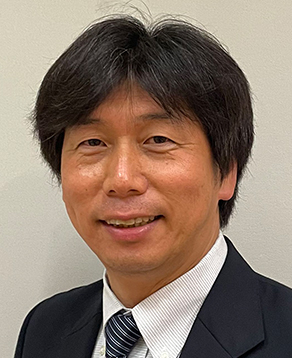
Prof. Akihiko Wakai
Professor, Gunma Univ.Graduate School of Science and Eng.
Specializes in disaster prevention, earth and foundationional disasters, etc. Research on computer-based phenomenon prediction, mechanisms for extreme weather/major earthquakes, and disaster mitigation measures.
Past Award Winners
-
10th Grand Prix (Highest Award)
Tamana City, Kumamoto Prefecture
Flood simulation using 3D city model
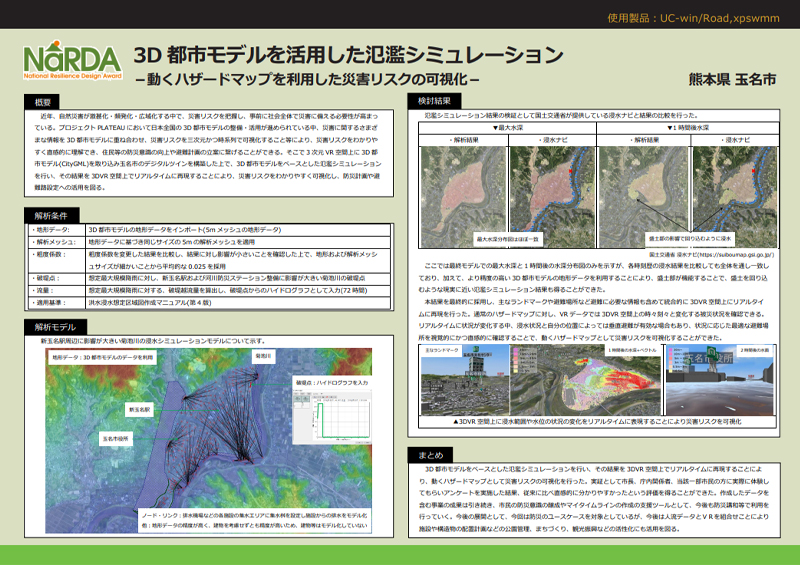 Program Used:UC-win/Road、xpswmm
Program Used:UC-win/Road、xpswmm
In recent years, as natural disasters have become more severe, frequent, and widespread, there has been a growing need for society as a whole to understand disaster risk and prepare for disasters in advance. As more and more 3D city models across Japan are developed and used in the Project PLATEAU, various disaster-related information is superimposed on the 3D city models to visualize disaster risks in 3D and in chronological order. This makes it easy to understand in an intuitive way, which can lead to improved disaster prevention awareness among residents and the formulation of evacuation plans. Therefore, a digital twin of Tamana City was created by incorporating a 3D city model (CityGML) into the 3D VR space, and a flood simulation was performed based on the 3D city model. The results were reproduced in real time in the 3D VR space, showing disaster risks in an easy-to-understand way. It is also planned to use them for disaster prevention planning and evacuation route determination. -
10th 2nd Prize (Excellence Award)
New Meishin Expressway Tenjingawa Bridge Design
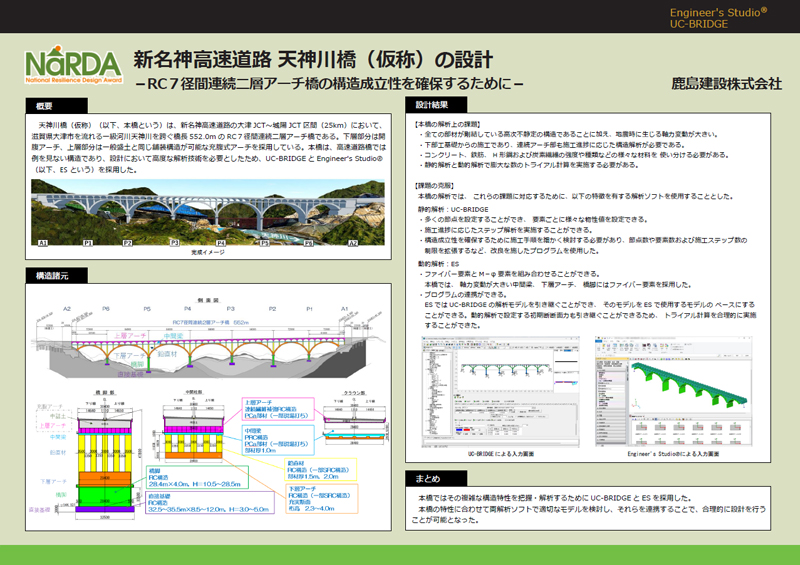 Program Used:Engineer's Studio®、
Program Used:Engineer's Studio®、
UC-BRIDGE・3DCAD(Partial Factor Method)
Tenjingawa Bridge (tentative name) is a 7-span continuous double-layer arch RC bridge with a length of 552.0 m. It is located between the Otsu JCT and the Joyo JCT (25 km) of the Shin-Meishin Expressway at the section over the Tenjingawa River, a first-class river flowing through Otsu City, Shiga Prefecture. The lower part is an open spandrel arch, and the upper part uses a solid spandrel arch, which allows a pavement structure similar to that of ordinary embankments. Because this bridge had a structure unprecedented in highway bridges, advanced analysis techniques were required in its design, and UC-BRIDGE and Engineer's Studio® were used for the analysis.
-
10th Honorable Judge Award (Prof. Hiromichi Yoshikawa)
Structural Performance-based Design AwardChiyoda Engineering Consultants Co., Ltd.
Seismic reinforcement design for a four-span continuous steel truss bridge
-
10th Honorable Judge Award (Prof. Masaru Morita)
Flood Inundation Management AwardFlood analysis of small rivers
-
10th Honorable Judge Award (Prof. Akihiko Wakai)
SDGs-Oriented Building Design Award
3-story building (S+RC structure) energy simulation
-
10th Nomination Award
Stress analysis of a widening monolithic bridge with different support conditions at the same support point
-
10th Nomination Award
Comparative verification of analysis methods for a water tank with a full opening
-
10th Nomination Award
Seismic reinforcement of existing steel reinforced suspension bridge
-
10th Nomination Award
Seismic reinforcement of existing agricultural irrigation facilities for level 2 earthquakes
Past Award Winners PickUp
-
9th Grand Prix (Highest Award)
Level 2 Earthquake Dynamic Nonlinear Analysis of Existing Overpass with Composite Piers
-
8th Grand Prix (Highest Award)
Seismic Study of Existing Steel Pipe Arch Water Pipe Bridge
-
7th Grand Prix
Nihon Suiko Consultant Co.,Ltd.
Comparison of seismic test result by using 2D and 3D model of existing water tank
-
5th Grand Prix
PENTA-OCEAN CONSTRUCTION CO., LTD.
Residual Strength Evaluation Method using Degradation to check Jetties
-
3rd Grand Prix
Nippon Concrete Industries Co., Ltd.
PC-wall to Retrofit Walls and Analysis During High Seismic Events
-
1st Grand Prix
Tonichi Design Consultant Co., Ltd.
Specifications for Highway Bridges Using 40-year-old Batter Brace Bridge
-
10th NaRDA (2023)
-
- [Grand Prix (Highest Award)]
Tamana City, Kumamoto Prefecture
- Flood simulation using 3D city model
- [2nd Prize (Excellence Award)]
KAJIMA CORPORATION
- New Meishin Expressway Tenjingawa Bridge Design
- [Honorable Judge Award]
Chiyoda Engineering Consultants Co., Ltd.
- Seismic reinforcement design for a four-span continuous steel truss bridge
Mizota Design Office
- Flood analysis of small rivers
TAKENAKA CORPORATION
- 3-story building (S+RC structure) energy simulation
- [Nomination Award]
KATAHIRA & ENGINEERS INC.
- Stress analysis of a widening monolithic bridge with different support conditions at the same support point
NTC Consultants Inc.
- Comparative verification of analysis methods for a water tank with a full opening
Nissin Tech
- Seismic reinforcement of existing steel reinforced suspension bridge
Knowledge Fusion Co., Ltd.
- Seismic reinforcement of existing agricultural irrigation facilities for level 2 earthquakes
Doboku Giken
- Study on the impact of construction near overpass bridges
- [Grand Prix (Highest Award)]
-
9th NaRDA (2022)
-
- [Grand Prix (Highest Award)]
KRAY Inc.
- Level 2 Earthquake Dynamic Nonlinear Analysis of Existing Overpass with Composite Piers
- 2nd Prize (Excellence Award)
Hagihara Giken Co., Ltd.
- Preliminary Study of Thermal Cracking Before Construction of New Bridge Abutments
- [Honorable Judge Award]
Chikyu Giken Consultant
- Re-analysis of Existing Water Distribution Basins and Verification of Reinforced Seismic Performance
Wakasuzu Consultants Co., Ltd.
- Liquefaction Analysis of Water Pipes
SK Engineering
- Impact Study of Propulsion Pipe Shaft Neighboring Work
- 【Nomination Award】
Knowledge Fusion Co., Ltd.
- Dynamic Analysis of Bridges Using Earthquake Motion Predicted by RNN
Yabu Doken Co., Ltd.
- Crack Examination by Temperature Stress Analysis of Caisson Foundation and Countermeasures
Ube Industries Consultant Co.,Ltd.
- Seismic Performance Verification of Arch Channel Bridge
FUJI Consultants Co.,Ltd.
- Seismic Performance Verification of a Simple Steel Truss Bridge Built in the 1950s
Kitacon Corporation
- Seismic Performance Verification of River Bridges with Box Structures
Sanei Sekkei
- Impact Study of Sewer Facility Neighboring Work
- [Grand Prix (Highest Award)]
-
8th NaRDA (2021)
-
- [Grand Prix (Highest Award)]
NiX Co., Ltd.
- Seismic Study of Existing Steel Pipe Arch Water Pipe Bridge
- [2nd Prize (Excellent Award)]
F-tech Inc.
- United Seismic Performance Verification of Civil Engineering Facility and Architectural Facility
- [Honorable Judge Award]
Knowledge Fusion Co., Ltd.
- Study on Bearing Capacity of RC Beam Members Using Nonlinear Structural Analysis Program
SANKYO ENGINEERING Co., Ltd.
- Level 2 Seismic Performance Verification for Pile-Bent Piers
SEED CONSULTANT,INC.
- Three-Dimensional Dynamic Nonlinear Analysis of a New Five-Span Continuous Steel Pedestrian Deck Bridge
- [Nomination Award]
ORBIT Co.,LTD.
- Level 2 Seismic Study of π-Shaped Rigid-Frame Bridge with PC Diagonal Members
FUJI Consultants Co.,Ltd.
- Single Column Dynamic Analysis by Modeling Pier Frame and Deep Foundation
Kyushu Electric Power Company, Incorporated
- Response Seismic Method of Ground
- [Grand Prix (Highest Award)]
-
7th NaRDA (2020)
-
- [Grand Prix (Highest Award)]
Nihon Suiko Consultant Co.,Ltd
- "Comparison of seismic test result by using 2D and 3D model of existing water tank"
- [2nd Prize (Excellent Award)]
Naigai Engineering Co., Ltd.
- "Seismic performance test using observed seismic motion"
- [Honorable Judge Award]
Sanpoh Co.,LTD
- "Rebar interference check using reverse T-type abutment CIM model"
Civil Engineering and Information Technology Consultants Inc.
- "Flood analysis in urban area"
Geo Formation
- "Influence of construction near railroad"
- [Nomination Award]
Sanei Sekkei
- "3D FEM beam model of a water treatment facility"
Aratani Civil Engineering Consultants CO.,LTD.
- "Seismic measure for continuous girder bridge using existing seismic bearing"
Epoch Design
- "Dynamic Ground Analysis on Tunnel"
- [Grand Prix (Highest Award)]
-
6th NaRDA (2019)
-
- [Grand Prix (Highest Award)]
Akita Prefectural University Faculty of Systems Science and Technology
- "Development of simple measurement technology for steel structures"
- [2nd Prize (Excellent Award)]
F-tech Inc.
- "Flood analysis of rivers in mountain area"
- [Honorable Judge Award]
SHO-BOND CORPORATION Nagoya Branch
- "Validity evaluation of reaction force for bearing design by difference of analysis model"
Knowledge Fusion Co., Ltd.
- "Disaster countermeasures for water supply facilities considering multi-hazards"
Kyushu Civil Engineering
- "Dike ground analysis"
- [Nomination Award]
JR Kyushu Consultants Company
- "JR Kagoshima Main Line track underlay propulsion impact analysis"
Namura Shipbuilding Co., Ltd.
- "Verification of installation method by cable erection method"
Morimatsu Industry Co., Ltd.
- "Proposal of water tank with seismic isolation device for huge earthquakes"
- [Grand Prix (Highest Award)]
-
5th NaRDA (2018)
-
- [Grand Prix (Highest Award)]
Institute of Technology, PENTA-OCEAN CONSTRUCTION CO., LTD.
- "Residual strength evaluation method using degradation level check to jetties"
- [2nd Prize (Excellent Award)]
Knowledge Fusion Co.,Ltd.
- "Seismic performance evaluation according to damage on material"
- [Honorable Judge Award]
KATAHIRA & ENGINEERS INC.
- "Stress analysis on the branch point of steel deck box girder bridge"
Kagoshima University
- "CFD analysis simulation of traditional architecture"
NIHON SAMICON CO., LTD.
- "Seismic performance verification for PC snow shed against L2 earthquake"
- [Nomination Award]
Cosmo Consultants Co., Ltd
- "Seismic verification of coastal embankment"
Marine Support Engineering
- "Seismic performance verification for additional piles against L2 earthquake and tsunami "
APPLIED TECHNOLOGY CO., LTD.
- "Seismic test for a steel intake tower"
Wakasuzu Co., Ltd.
- "Evaluating damage on existing bridge foundation caused by L2 earthquake"
- [Grand Prix (Highest Award)]
-
4th NaRDA (2017)
-
- [Grand Prix (Highest Award)]
Next Energy & Resources Co., Ltd.
- "Design of solar cell support structure"
- [2nd Prize (Excellent Award)]
Nippon Concrete Industries Co., Ltd.
- "Consistency by full scale experiment and nonlinear pushover analysis for PC-wall"
- [Honorable Judge Award]
CIVIC ARTS Consulting Inc.
- "Seismic performance evaluation of eight-continuous water gate"
APPLIED TECHNOLOGY CO., LTD.
- "Seismic performance check of hydraulic steel pipe for power generation"
Japan Association of Diaphragm Wall
- "Strength test analysis by steel diaphragm wall method-II"
- [Nomination Award]
Takenaka Corporation
- "Annual load calculation analysis of exterior"
Ahbo, Inc.
- "Analytical review on cracks in a lid of side ditch"
Wakasuzu Consultants Co., Ltd. Oita office
- "Ground analysis of gas pipe displacement"
- [Grand Prix (Highest Award)]
-
3rd NaRDA (2016)
-
- [Grand Prix (Highest Award)]
Nippon Concrete Industries Co., Ltd.
- "High seismic retrofitting of freestanding retaining wall by using PC-Wall and reasonable performance verification type seismic design method"
- [2nd Prize (Excellent Award)]
Association of road and bridge structure, Ministry of Land, Infrastructure, Transport and Tourism. Central Regional Development Bureau
- "Utilize Engineer's Studio® for personnel training"
- [Honorable Judge Award]
A x C
- "Experimental result about sewerage facilities if applying non-linear FEM analysis, and limit value based on the result"
Oita National College of Technology
- "Shallow water equations based tsunami attack simulation with the idea of disaster prevention on software"
APPLIED TECHNOLOGY CO.,LTD.
- "Verification of tsunami load against shell-type roller gate by using FEM"
- [Nomination Award]
Totetsu Mfg. Co.,Ltd.
- "Structure characteristic understanding of rainwater storage and infiltration facilities "aquapalace method""
Sankyo Technology Co., Ltd.
- "Seismic performance verification and reinforcement analysis of the existing RC ramen pier"
JAPAN-CHINA CONSULTANT Co., LTD Nagoya Office
- "Seismic verification of a water pumping facility"
- [Grand Prix (Highest Award)]
Product Info
FEM Analysis
Engineer's Studio® Dynamic non-linear analysis of 3D laminated plates and cables
FEMLEEG® Comprehensive finite element method analysis system
WCOMD Studio
Geotechnical Analysis(GeoFEAS® VGFlow®/Geo Engineer's Studio/ 2D elasto-plastic ground analysis GeoFEAS®2D/Dynamic Stress Analysis for Ground UWLC/3D Slope Stability Analysis LEM3D/2D seepage analysis (VGFlow)
UC-1 Series
Structural Analysis、Bridge Superstructures、Bridge Substructures、Foundation Work、Temporary Construction、Road/Earth work、Waterworks,etc.
Referral Program
Analysis Support Services




